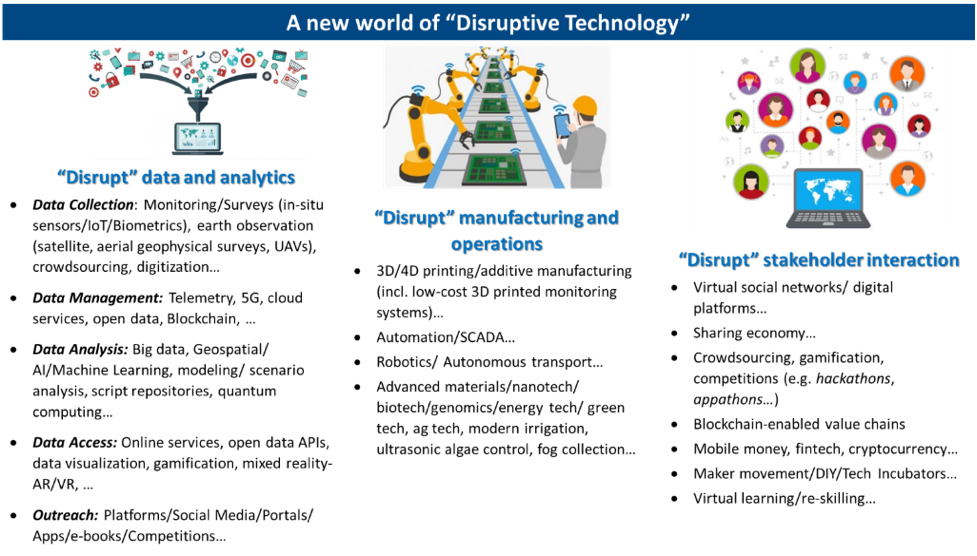Technological “Disruption”
The water sector faces increasing pressures especially due to the impact of climate change. In the developing world governments will have to increase resilience and sustainability within the sector, within water scarcity and safety, water efficiency, operations of utilities, the treatment and monitoring of water resources and the generation of data and analytics, technology will play a critical role. Globally, there is a growing willingness of to test and adopt some of these new technologies among utilities and operators; technologies such as remote sensing of water which can help with water accounting, non-revenue water remediation, artificial intelligence and big data also offer the capability now to analyze large volumes of water data to aid in decision support and policy making for the sector, in the area of water in agriculture , the internet of things is also enabling smart irrigation for efficient use of water.
These technologies also help utilities to move to serving customers digitally, enable remote and real time management of water resources, utilize distributed technology for the expansion of water and wastewater management services to communities. ( World Bank )

More information on this growing world of new technologies here. There are many examples of how this new world is changing or expected to change a range of “sectors”. In fact, a key implication of these technologies is that they both require and enable us to think beyond the comfort zone of traditional “sectoral” boundaries.
Some of the ways in which watershed planning and management could be very different in future include:
A new generation of global data/analytic services that can be adapted to dashboards and decision support tools at different scales (e.g. region/country/state…local/community levels or basin/sub-basin…micro-watershed levels).
New ways of communicating with communities (including soliciting inputs, reviewing information together using interactive tablets, etc.)
However, there could also be new challenges in the form of privacy, cybersecurity, and changes in jobs as many traditional activities get automated or become obsolete due to the changes in technology.
COVID-19 Context
The COVID-19 pandemic has disrupted life globally and it may be many years before the world is “post-COVID”. South Asia has been particularly impacted given the density of population and poverty. According to the World Bank’s 2021 Global Economic Prospects report, the pandemic has had a devastating impact on the South Asian region leading to an estimated 6.7 percent output contraction in 2020. Even more so, the region is projected have a lower growth rate of 3.3 percent in 2021 and 3.8 percent in 2022 comparatively weaker than in the decade preceding the pandemic.
A key aspect of some of the investments in a watershed context is that they provide a way to enhance creation of employment (some temporary and some more as livelihood opportunities), in remote dispersed communities. These could be extremely useful in the current COVID context where there is a need to provide monetary support to far-flung poor communities. Technology such as spatial surveys could be used to collect information about potential community-level investments that can be visualized in interactive dashboards for prioritization and packaging into investments. An illustrative example is shown below.
In the 1930s, to recover from the Great Depression, President of the USA, Franklin D. Roosevelt launched a large-scale employment program called the Civilian Conservation Corps (CCC), employing 3 million individual jobs over the next 9 years of the program. The program was credited for planting 2.3 billion trees and arresting erosion on more than 20 million acres over its course. Countries in South Asia face very similar challenges today due to COVID-19 but at a much larger scale. Majority of unemployed people in South Asia are low-skilled, daily wage earners working in the informal sector without social safety nets. A program like CCC in South Asia can help employ millions in the region and prevent environmental degradation.